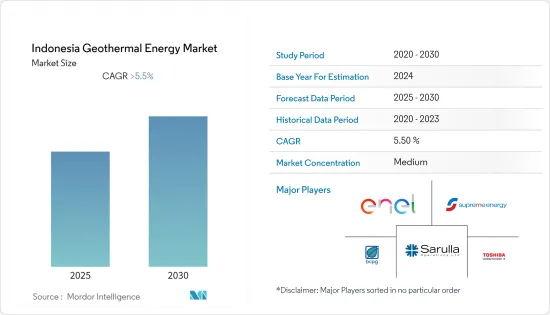
|
市場調査レポート
商品コード
1628751
インドネシアの地熱エネルギー-市場シェア分析、産業動向と統計、成長予測(2025年~2030年)Indonesia Geothermal Energy - Market Share Analysis, Industry Trends & Statistics, Growth Forecasts (2025 - 2030) |
||||||
カスタマイズ可能
適宜更新あり
|
|||||||
| インドネシアの地熱エネルギー-市場シェア分析、産業動向と統計、成長予測(2025年~2030年) |
|
出版日: 2025年01月05日
発行: Mordor Intelligence
ページ情報: 英文 90 Pages
納期: 2~3営業日
|
全表示
- 概要
- 目次
インドネシアの地熱エネルギー市場は予測期間中に5.5%以上のCAGRで推移する見込み。

COVID-19は市場に悪影響を与えました。現在、市場はパンデミック以前のレベルに達しています。
主要ハイライト
- 長期的には、化石燃料への依存度を減らし、それによってCO2排出量を削減しようとする政府の取り組みが市場の主要促進要因となります。予測期間中、電力需要の増加が市場を牽引すると考えられます。
- その一方で、地熱エネルギーは化石燃料による電力よりも高価であり、太陽光や風力のような他の再生可能エネルギーとの競合も多いため、予測期間中の市場成長は鈍化すると予想されます。
推定人口が2億9,600万人で、2030年までに都市化率が71%に上昇することから、電力需要は伸びると予想されます。インドネシア政府は、2030年までにCO2排出量を29%削減したいと考えています。これは、増大する電力需要に対応するために再生可能エネルギーの利用を増やすことで実現する可能性が高いです。これは近い将来、地熱市場に成長の機会を与えると考えられます。
インドネシアの地熱エネルギー市場動向
電力需要の増加が市場を牽引する可能性が高い
- インドネシアの人口と都市の成長に伴い、電力に対するニーズは年々高まっています。2021年には、インドネシアの電力消費量は1億6,838万BOE(石油換算バレル)に達します。
- 2021年、インドネシアの家庭部門の総電力消費量は約7,028万9,000BOEでした。家庭の電力消費量が最も多く、電力消費量全体の約41.7%を占めています。
- インドネシアの家庭用電力需要は350 TWhまで増加すると推定されています。一方、工業部門と商業部門の需要はそれぞれ約80TWhと70TWhに増加すると予想されています。
- 家庭部門における電化製品の使用が電力消費量増加の主要要因になると予想されます。対照的に、金属産業、化学産業、食品産業、繊維産業が産業用電力消費の主要原動力になると予想されます。
人口の増加に伴い、インドネシアの世帯数は2050年までに8,000万世帯近くまで増加すると予想されます。そのため、今後数年間で電力使用量が増加する可能性が高いです。政府が再生可能エネルギーによる電力量を増やそうとしているため、電力源となりうる地熱エネルギーは今後数年間で成長すると予想されます。
今後の石炭火力発電所が市場成長を制限する可能性が高い
- 2021年、インドネシアの発電所設備容量は7万4,532.94MW近くまで増加し、2020年の容量と比較すると約7万2,750.73MWとなりました。総設備容量は約51.8%で、蒸気発電所が2021年の発電所産業を支配しました。
- 2021年の燃料別一次エネルギー消費量は8.31エクサジュールで、石炭39%、天然ガス16%、石油34%、再生可能エネルギー7.5%でした。
- 同国は石炭を燃料とする発電所への依存度が高いため、既存の石炭発電所を稼働させながら、新たな石炭発電所を建設する計画があります。2021年の石炭によるエネルギー消費量は8,782万BOE(石油換算バレル)でした。
- 2022年11月、インドネシア政府は、すでに入札が行われていた総発電容量13ギガワットの石炭発電所の新設を許可しました。同国の2021~2030年までの10カ年エネルギー計画は、この戦略を明示しています。注目すべきは、ジョコ・ウィドド大統領が2022年に"キャプティブ石炭発電所"の開発を認める法律に署名したことです。
- 石炭火力発電所の容量を増やすことは、電力を作る方法の大きな部分を占めると予想されます。今後数年間は、増加する電力需要のほとんどを満たすことになると考えられます。このため、インドネシアの地熱エネルギーやその他の再生可能エネルギー源の成長は鈍化すると予想されます。
インドネシアの地熱エネルギー産業概要
インドネシアの地熱エネルギー市場は、適度に統合されています。同市場における主要参入企業(順不同)としては、Enal SpA、Toshiba Energy Systems & Solutions Corporation、BCPG Public Company Limited、PT Supreme Energy、Sarulla Operations Ltd.などが挙げられます。
その他の特典
- エクセル形式の市場予測(ME)シート
- 3ヶ月間のアナリストサポート
目次
第1章 イントロダクション
- 調査範囲
- 市場の定義
- 調査の前提
第2章 エグゼクティブサマリー
第3章 調査手法
第4章 市場概要
- イントロダクション
- 2027年までの設置容量と予測(単位:MW)
- 最近の動向と開発
- 政府の規制と施策
- 市場力学
- 促進要因
- 抑制要因
- サプライチェーン分析
- PESTLE分析
第5章 競合情勢
- M&A、合弁事業、提携、協定
- 主要企業の戦略
- 企業プロファイル
- Enal SpA
- Toshiba Energy Systems & Solutions Corporation
- BCPG Public Company Limited
- PT Supreme Energy
- Sarulla Operations Ltd.
第6章 市場機会と今後の動向
The Indonesia Geothermal Energy Market is expected to register a CAGR of greater than 5.5% during the forecast period.

COVID-19 had a detrimental effect on the market. Presently, the market has reached pre-pandemic levels.
Key Highlights
- Over the long term, the primary driver for the market will be the government's efforts to reduce the country's dependency on fossil fuels and thereby reduce CO2 emissions. Increasing electricity demand is likely to drive the market during the forecast period.
- On the other hand, geothermal energy is more expensive than power from fossil fuels, and there is more competition from other renewable energy sources, like solar and wind, which is expected to slow market growth during the forecast period.
Nevertheless, with an estimated population of 296 million and an increased urbanization rate of 71% by 2030, electricity demand is expected to grow. The Indonesian government wants to cut CO2 emissions by 29% by 2030. This is most likely to be done by increasing the use of renewable energy to meet the growing electricity demand. This is likely to give the geothermal market a chance to grow in the near future.
Indonesia Geothermal Energy Market Trends
Increasing Demand for Electricity is Likely to Drive the Market
- Indonesia's need for electricity has grown over the years as the country's population and cities have grown. In 2021, the electricity consumption in Indonesia accounted for 168.38 million BOE (barrel oil equivalent).
- In 2021, the total electricity consumption of the household sector in Indonesia was nearly 70,289 thousand BOE. Households consumed the highest percentage of electricity, with almost 41.7% of the total electricity consumed.
- It is estimated that the household electricity demand in Indonesia is likely to increase to 350 TWh. In contrast, demand in the industrial and commercial sectors is expected to rise to about 80 TWh and 70 TWh, respectively.
- The use of electronic appliances in the household sector is expected to be the primary driver of the increase in electricity consumption. In contrast, the metal, chemical, food, and textile industries are expected to be the major drivers for industrial electricity consumption.
With a growing population, Indonesian households will likely grow to almost 80 million by 2050. This will likely increase the amount of electricity used in the coming years. Geothermal energy as a possible source of electricity is expected to grow over the next few years because the government is trying to increase the amount of electricity made from renewable energy.
Upcoming Coal Fired Power Plant is Likely to Restrict the Market Growth
- In 2021, Indonesia's power plant installed capacity increased to nearly 74,532.94 MW, which was around 72,750.73 MW compared to the capacity in 2020. With a total installed capacity of about 51.8%, steam power plants dominated the power plant industry in 2021.
- In 2021, primary energy consumption by fuel accounted for 8.31 exajoules, which were generated from 39% coal, 16% natural gas, 34% oil, and 7.5% renewables.
- The country has a high reliance on coal-based power plants; thus, there are plans to build new coal power plants with existing coal power plants in operation. In 2021, energy consumption from coal accounted for 87.82 million BOE (barrel oil equivalent).
- In November 2022, the Indonesian government permitted the building new coal plants that had already been bid out and had a total capacity of 13 gigawatts. The country's 10-year energy plan for 2021-2030 lays out the strategy. Notably, President Joko Widodo signed legislation into law in 2022, allowing the development of "captive coal plants."
- Increasing the capacity of coal-fired power plants is expected to make up a big part of how electricity is made. It will likely meet most of the growing demand for electricity over the next few years. This is expected to slow the growth of the country's geothermal energy and other renewable sources.
Indonesia Geothermal Energy Industry Overview
The Indonesia geothermal energy market is moderately consolidated. Some of the key players in the market ( not in particular order ) include Enal SpA, Toshiba Energy Systems & Solutions Corporation, BCPG Public Company Limited, PT Supreme Energy, and Sarulla Operations Ltd.
Additional Benefits:
- The market estimate (ME) sheet in Excel format
- 3 months of analyst support
TABLE OF CONTENTS
1 INTRODUCTION
- 1.1 Scope of the Study
- 1.2 Market Definition
- 1.3 Study Assumptions
2 EXECUTIVE SUMMARY
3 RESEARCH METHODOLOGY
4 MARKET OVERVIEW
- 4.1 Introduction
- 4.2 Installed Capacity and Forecast in MW, till 2027
- 4.3 Recent Trends and Developments
- 4.4 Government Policies and Regulations
- 4.5 Market Dynamics
- 4.5.1 Drivers
- 4.5.2 Restraints
- 4.6 Supply Chain Analysis
- 4.7 PESTLE Analysis
5 COMPETITIVE LANDSCAPE
- 5.1 Mergers and Acquisitions, Joint Ventures, Collaborations, and Agreements
- 5.2 Strategies Adopted by Leading Players
- 5.3 Company Profiles
- 5.3.1 Enal SpA
- 5.3.2 Toshiba Energy Systems & Solutions Corporation
- 5.3.3 BCPG Public Company Limited
- 5.3.4 PT Supreme Energy
- 5.3.5 Sarulla Operations Ltd.

